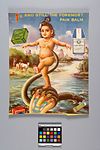Calendar
About this object
History of use
Indian popular religious prints have been published for nearly a century, first by German presses, latterly by Indian ones. The prints may take the form of calendars, posters, or simply images. The style of the representations is European. In the beginning they were Hindu images, but are now acquiring elements both of folk art and a romantic secularism. It is a living art currently influenced by the movie industry and non-Hindu religions. The images are a vehicle for advertising and are also used for religious worship.
Cultural context
calendar art; popular religious art
Iconographic meaning
Krishna, the eighth manifestation of Vishnu, with the attribute of Vishnu, the naman, on his forehead. The peacock feather in his hair is an attribute of Krishna, with the cows in background referring to his early life among the cowherds in the region of Vrindaban, hiding from Kansa. This image depicts Krishna's struggle with the demon king, Kaliya, who had taken the shape of a snake and was living in the river Yamana, poisoning the water with his venom and making it lethal to birds and animals. Krishna wins battle. With all the weight of the universe, he jumps upon the snake's head and starts to dance. The snake spits blood and collapses.
Physical description
Rectangular shaped calendar print. Depicted in the foreground is a young Krishna standing on middle head of five-headed snake which has risen out of a body of water. Child is standing on one foot with the left foot raised. Gold bracelets are on all ankles and wrists, three necklaces around neck and one gold earring in each ear. Child has a peacock feather in hair and a red u shape on forehead between eyes. In the background are two cows on left stand in front of forest. Water moves into background to the right. Tops of buildings visible on left and centre of print behind trees. Blue sky with some white and light purple clouds. Superimposed, written advertisements for medical supplies in each of the four corners of the print. Written, in red and yellow across top: '1st and still the foremost pain balm'.
Categories
Materials
